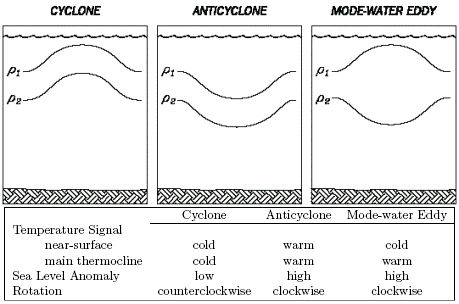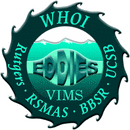|
 
|
|
|
At Sea
|
|
 |
|
2004 Season Field
|
|
|
|

|
|
Ship operations summary
|
|
Survey 1
|
|
|
|
| Survey 2 |
|
|
|

|
|
|
|
2005
Season Field
|
|
|
|
|
|
|
|
|
|
|
|
|
|
|
|
|
|
|
|
|
|
|
|
|
|
|
|
EDDIES Home => At Sea => 2004 Season Field => Summary
|
|
|
|
|
|
|
|
|
|
|
Selection
of
the target eddy feature
|
|
|
|
|
|
Real-time
analysis of altimetric observations will provide maps of the eddy field
prior to and during our sampling operations (Figure 1).
|
|
|
|
|
|
 |
|
|
|
|
|
Figure
1: Example objective analysis of sea level anomaly (SLA) for 10 July
2003. Near real-time data feeds from
Jason, Topex, Geosat Follow On, and ERS were obtained through the
Colorado Center for Astrodynamics Research Real-Time Altimetry Project;
see http://www-ccar.colorado.edu/~realtime/welcome/.
|
|
|
As far as we know, there are three different
types of mid-ocean eddies in the Sargasso Sea (Figure 2): cyclones,
anticyclones, and mode-water eddies (MWEs). Cyclones
and MWEs are of interest to this project, as both tend to displace
upper ocean isopycnals toward the surface, causing nutrient input into
the euphotic zone. Whereas cyclones are
identifiable in satellite altimetry by virtue of their negative sea
level anomaly (SLA), MWEs are not distinguishable from anticyclones on
the basis of altimetry alone becauseboth result in positive SLA. In principle, satellite-based SST could
distinguish these two, as anticyclone and MWEs would be characterized
by warm and cold SST anomalies, respectively. However,
given the paucity of reliable SST imagery in the Sargasso Sea during
summer, we will likely have to rely on in situ measurements to
unequivocally distinguish MWEs from anticyclones.
|
|
|

|
|
|
Eddy age is another key issue.
Whereas an intensifying cyclone will have
upwelling in its center, the isopycnals in the interior of a decaying
cyclone will be downwelling. The earlier
phase of the eddy’s lifetime will be when nutrient injection and the
associated biological response occur.
Summary of desirable characteristics for the
target eddy:
1. Young
2. Strong imprint on upper ocean physics, biology, and chemistry (not
necessarily a large amplitude SLA in the case of a MWE).
3. Intensifying
4. Chemical impact discernible in real time (optical NO3
sensor)
5. Biological impact discernible in real time
(fluorometry, microscope counts, VPR?)
6. Cyclone versus MWE?
a. unequivocal satellite determination favors cyclones
b. trapping of near-inertial motions and possible enhanced
mixing favors MWEs
c. some of the big events at BATS have been MWEs
Jenkins
(1988) Summer 1986 event
McNeil et al. (1999) July 1995 eddy.
7. Proximity to BBSR: must be within 1 day’s steam for Weatherbird
II
Clearly, it will behoove us to sample
several eddies
during the first survey cruise prior to making a decision about which
eddy
we wish to spend the rest of the summer in.
Eddy statistics from
prior years can provide some guidance as to
what to expect: |
|
|
|
|
| Figure
3. Eddy tracks for June through August, 1993-2001, 2003.
Cyclones are in blue, and anticyclones
are in red. |
|
|
|
|
|
|
See also:
Project Summary and Cruise Logistics:
HTML document updated April 7, 2004
Word file (.doc) of same
Powerpoint file from project meeting
July 23, 2003
|
|
|
|
|
|
back to top
|
|
|
|




